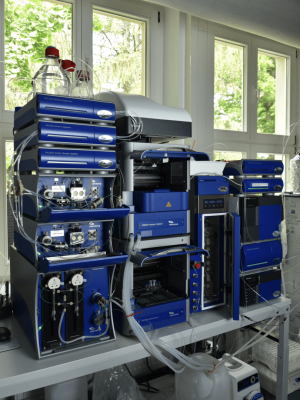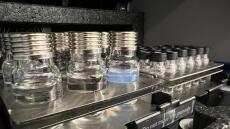Flow-field-flow fractionation
Flow-field-flow fractionation system (AF4)
Image: Anne Günther (University of Jena)Nanoparticulate suspensions can have a high complexity in size distribution and composition of individual natural or artificial components. Bulk analysis methods such as dynamic light scattering (DLS) to determine the hydrodynamic diameter, zeta potential for the charge behavior or ICP-MS to analyze the total element content, provide average information on sizes, charges and contents. However, size-dependent differences in composition and charge behavior are neglected.
To solve these analytical challenges, we use a flow-field-flow fractionation system (AF4) with an asymmetric separation channel in combination with a multidetector and coupling system. In this system, multimodal nanoparticulate suspensions are fractionated in a planar separation channel via a flow gradient so that individual particle populations with the same hydrodynamic properties in the range from 1 nm to 1000 nm can be analyzed in subsequent detectors. This allows size-dependent properties to be analyzed. Furthermore, an electric field can be used in combination with the flow gradient to separate according to charge properties. This allows the zeta potential of the individual size populations to be analyzed.
In addition to the analysis of nanoparticulate phases down to the lower single-digit nanometer range, the smallest nanoparticulate phases and low-molecular solution components in the range from 30 kDa to 100 Da can be separated and analyzed using a size exclusion chromatography in addition.
Equipment
(Postnova Analytics GmbH)
- Quaternary pump system for online eluent mixing of up to 4 different solutions
- Autosampler
- Fraction collector (for e.g. subsequent imaging analysis of fractionated samples or element analysis using ICP-MS)
- Analytical separation channel (with electrical separation option)
- Ultrafiltration membranes for analytical channel (300 Da - 10 kDa)
- Hollow fiber channel (10 kDa)
- Columns for aqueous size exclusion chromatography (SUPREMA 30Å, 8 x 300 mm, 3 µm; Agilent Technologies)
- Dual wavelength UV detector
- Static light scattering detector - MALS (21 angles)
- Fluorescence detector
- Dynamic light scattering detector (DLS; Malvern Zetasizer ZS)
- ICP-MS coupling module
- NovaAnalysis analysis software with extended software modules
Sample preparation
Aqueous samples for separation using AF4 should not contain any particulate phases larger than 1000 nm (1 µm) and may contain up to 20 % v/v methanol. Depending on the number concentration of nanoparticulate phases in the sample, a few µL up to 250 µL sample volume per measurement can be used. For measurements using size exclusion chromatography, the samples should be filtered at least via 0.45 µm or better via 0.02 µm.
The largest volume for measurements by AF4 is required during method development, which is necessary for each new sample matrix. Therefore, ideally 5 - 10 mL of sample volume is required for initial method development. Otherwise, 1 – 2 mL are sufficient.
If sample volumes should be collected by fraction collection, a correspondingly larger volume must be available. For further advice on the subsequent analysis, please do not hesitate to contact us.






